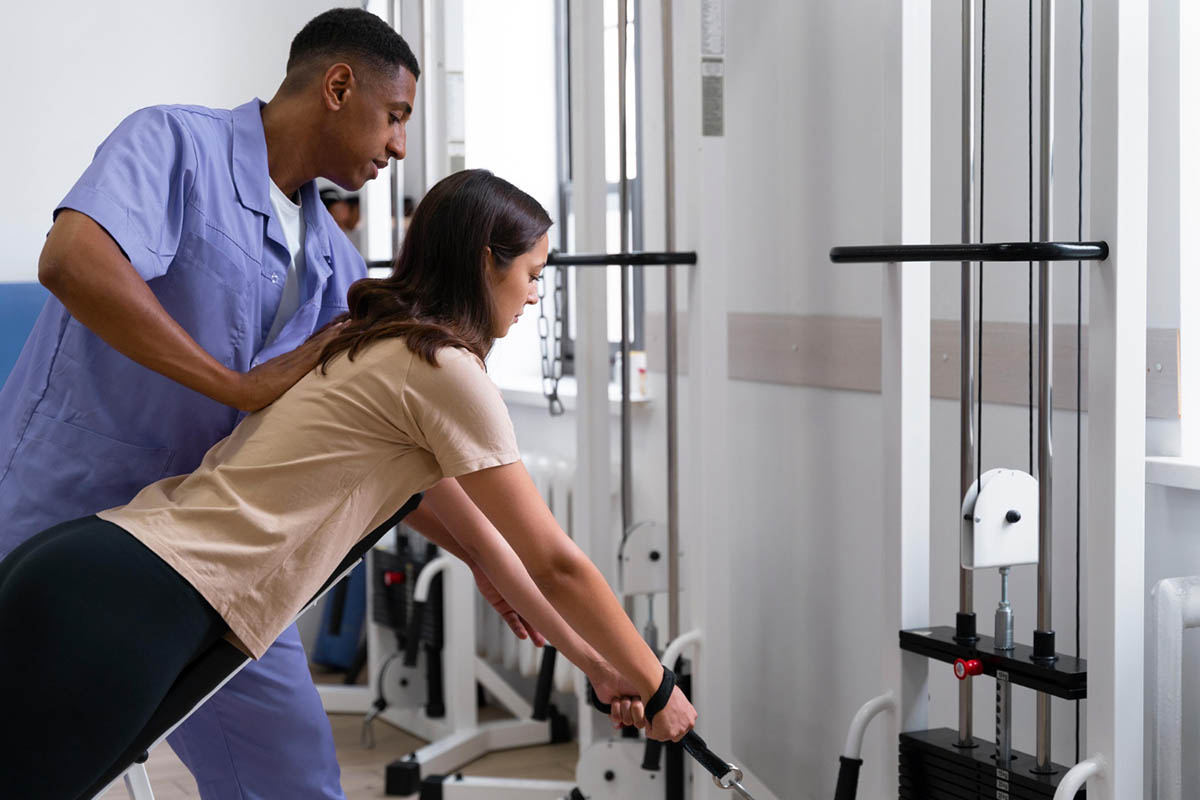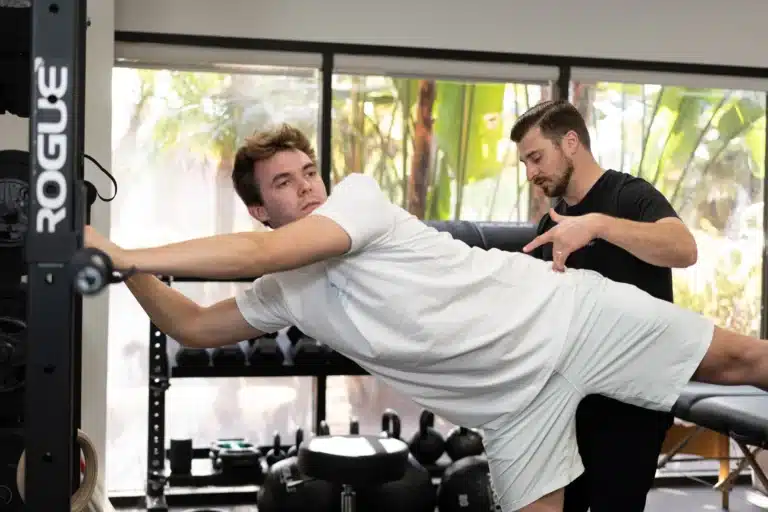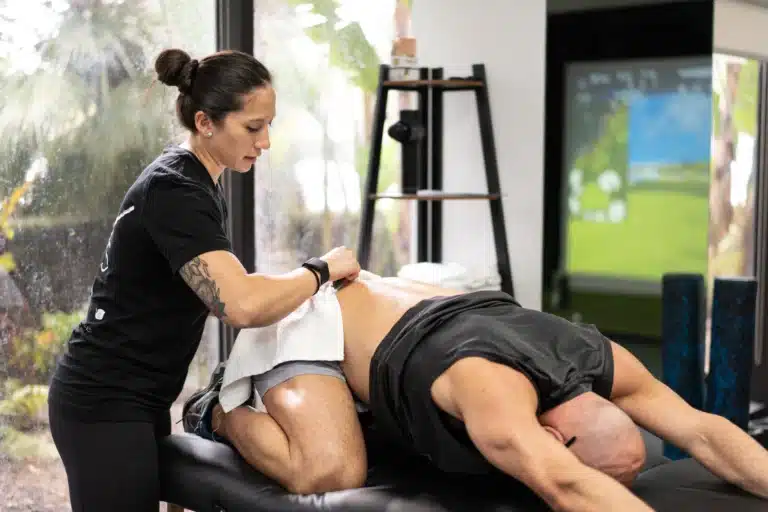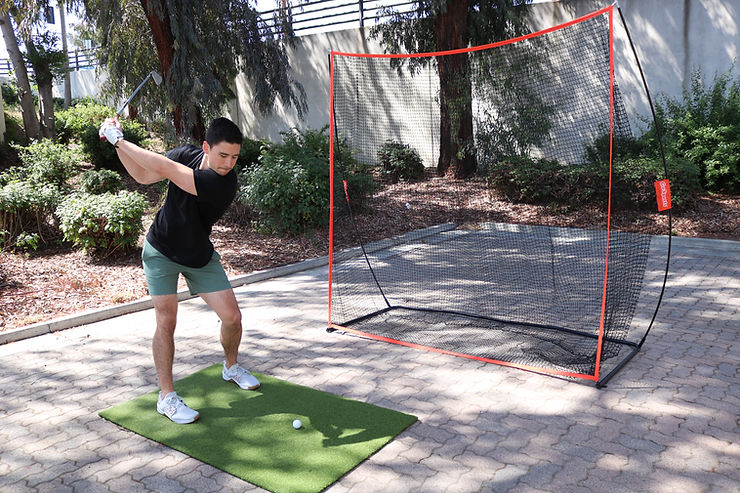A dislocated shoulder is a painful and debilitating injury that can significantly impact daily life. Shoulder dislocation occurs when the upper arm bone (humerus) ball pops out of the shoulder socket. Given the shoulder’s extensive range of motion, it’s one of the most common dislocated joints. Recovery from this injury requires a strategic dislocated shoulder physical therapy plan to restore full function, minimize the risk of future injuries, and prevent long-term complications. At The Movement Schopp, we specialize in providing expert guidance for physical therapy and rehabilitation, ensuring a smooth healing process. This article explores the phases of rehabilitation, exercises to aid recovery, and key prevention strategies to help you heal effectively, guiding you on your path to recovery.
What is a Shoulder Dislocation?
A shoulder dislocation happens when the head of the humerus is forced out of the glenoid, the socket within the shoulder blade. This condition is most often the result of trauma, such as a fall, accident, or a sudden impact during sports. Posterior dislocations, where the shoulder dislocates backward, are less common but significant. Anterior dislocations, where the shoulder dislocates forward, are the most common, accounting for up to 97% of all shoulder dislocations.
Common Causes and Symptoms
Shoulder dislocations can result from various factors. Trauma or injury, often seen in high-impact sports like football or skiing, as well as accidents such as falling onto an outstretched arm, are frequent culprits, particularly in contact sports. Additionally, repetitive overhead movements like swimming or throwing can contribute to shoulder instability. Moreover, specific individuals may be genetically predisposed to shoulder dislocations due to hyperlaxity, which refers to looser ligaments that increase vulnerability to injury, especially in mobile joints. If you’re experiencing any of these symptoms, consider searching for shoulder physical therapy near me to begin your recovery journey.
When a shoulder dislocation occurs, individuals typically experience immediate and intense symptoms, including sharp and severe shoulder pain. This may be accompanied by an inability to move the affected arm and a noticeable deformity or bump at the shoulder’s front or back. Additional signs can include swelling and bruising around the injury site and numbness or tingling sensations in the arm, indicating possible nerve involvement.
Shoulder Dislocation Rehab Exercises

Shoulder physical therapy is critical to the recovery process following a shoulder dislocation. A structured rehabilitation program helps restore shoulder strength, flexibility, and stability, aiming to improve quality of life. Exercises vary based on the recovery stage, ranging from gentle movements to more advanced strengthening as healing progresses.
Exercises to Do While Your Arm is in a Sling
When your arm is immobilized in a sling, it’s essential to start with isometric exercises to maintain shoulder mobility and prevent stiffness.
- Modified Shoulder Flexion & Extension: While seated or standing, use your non-injured arm to support the movement of your injured arm. Gently lift the wounded arm forward and return it to the starting position. This exercise helps maintain shoulder mobility.
- Shoulder External Rotation: While in a sling, external rotation helps prevent the shoulder joint from becoming too stiff. With your elbow bent and held close to your side, gently rotate your forearm outward. Ensure that this movement is small and controlled.
- Shoulder Internal Rotation: Similar to external rotation, internal rotation involves rotating your arm inward toward your abdomen. This movement helps keep the muscles around the shoulder joint active without causing strain.
Exercises After the Sling is Removed
Once the sling is removed, it’s time to focus on restoring strength and stability in the shoulder. These shoulder physical therapy exercises are designed to improve mobility and gradually build muscle strength.
- Shoulder Flexion: Stand upright and raise your arm in front of you to shoulder height, then lower it back down slowly. This movement strengthens the muscles responsible for shoulder flexion while promoting proper range of motion, aiding in the road to recovery.
- Shoulder Abduction: Lift your arm out to the side, keeping it straight, and raise it until it’s parallel to the floor. Shoulder abduction helps strengthen the deltoids and surrounding muscles that support shoulder movement.
- Wall Push-Ups: Wall push-ups gently engage the muscles around the shoulder without overloading the joint. Stand facing a brick wall with your arms and feet shoulder-width apart. Perform a push-up motion by bending your elbows and lowering your chest toward the wall, then push back to the starting position.
- Internal and External Rotation Strengthening: Using a resistance band or a lightweight one, strengthen internal and external rotators by rotating your arm inward and outward with your elbow at a 90-degree angle. These movements are essential for stabilizing the shoulder and preventing future dislocations.
Stretches to Support Recovery
Incorporating stretches into your routine helps improve flexibility, reduce stiffness, and promote overall shoulder health, an essential part of the shoulder dislocation rehabilitation plan.
- Towel Stretch: Hold a towel behind your back and reach over your shoulder to grab the top end with the other hand. Gently pull the towel upward with your top hand to stretch the shoulder. This exercise improves internal rotation and flexibility.
- Cross-Body Stretch: Bring your injured arm across your chest and gently pull it closer with your non-injured hand. This stretch targets the posterior shoulder muscles and helps relieve tension, supporting a range of movement.
- Lying Overhead Stretch: Lie on your back and hold a stick or towel in both hands. Slowly raise your arms overhead while keeping your elbows straight. This stretch enhances shoulder flexion and mobility.
What Exercises to Avoid After Shoulder Dislocation
While shoulder therapy exercises are essential, avoiding specific movements that could hinder your progress or risk re-injury is just as important for an effective recovery journey.
- Overhead Weight Lifting: Lifting weights above your head puts significant stress on the shoulder joint and can easily lead to re-injury, especially in the early stages of recovery.
- Throwing Movements: Throwing a ball or engaging in sports like baseball or basketball should be avoided until the shoulder is fully stable and strong. These rapid, forceful motions can cause the shoulder to dislocate again.
- Some Swimming Strokes: Freestyle and butterfly strokes involving overhead arm movements should be avoided until your physical therapist advises that your shoulder is ready.
When to Seek Professional Help
While home exercises are beneficial, consulting a physical therapist is critical for a successful recovery. A physical therapist can guide you through safe and effective rehabilitation, ensuring you perform the correct movements at each stage of healing.
- The Role of a Physical Therapist in Recovery: A physical therapist tailors exercises based on your unique needs and progress, monitors your shoulder’s stability, and adjusts your recovery plan accordingly, ensuring a comprehensive rehabilitation program.
- Surgical Considerations: Surgery may sometimes be required, especially for younger patients with repeated dislocations. Patients under 20 years old have a 90% chance of recurrence, while those older than 40 years have only a 10% recurrence rate but are more prone to rotator cuff injuries. The study concluded that men, patients younger than 40 years at initial dislocation, shorter time from initial dislocation, hyperlaxity, and lack of more significant tuberosity fracture were key risk factors that increase the risk of recurrent instability after first-time traumatic anterior shoulder dislocations in adults. Surgical treatment may be recommended to repair torn ligaments or prevent future dislocations.
Prevention Tips for Shoulder Dislocation

Once your shoulder has healed, it’s important to adopt strategies to prevent future shoulder dislocations. Strengthening exercises and protective movements can significantly reduce the risk of recurrence, ensuring recurrent shoulder instability is minimized.
- Strengthening Exercises: Continue building shoulder strength with exercise band or surgical tubing resistance exercises that target the rotator cuff, deltoids, and surrounding muscles. These exercises improve shoulder stability.
- Improving Flexibility: Stretching regularly helps maintain shoulder flexibility and range of motion, reducing the risk of injury.
- Protective Movements in Sports and Everyday Life: Be mindful of shoulder movements during sports and daily activities. Avoid awkward positions, such as overhead movements or reaching too far backward, which can strain the joint.
Conclusion
Recovering from a dislocated shoulder requires proper physical therapy, consistent exercises, and prevention strategies. Working closely with a physical therapist ensures a safe recovery while minimizing the risk of future dislocations. Focusing on strength, flexibility, and mindful movements can help you regain full shoulder function and reduce the chance of recurrence.
FAQs
How long does it take to recover from a dislocated shoulder?
Recovery time can range from several days to weeks to a few months, depending on the dislocation’s severity and the rehabilitation program’s effectiveness.
When can I return to sports after a shoulder dislocation?
Most individuals can return to sports 3 to 6 months after dislocation, depending on the sport and the shoulder’s stability.
Can a dislocated shoulder heal without surgery?
Yes, many shoulder dislocations heal without surgery, but it depends on the individual’s age, the severity of the dislocation, and the likelihood of recurrence.




